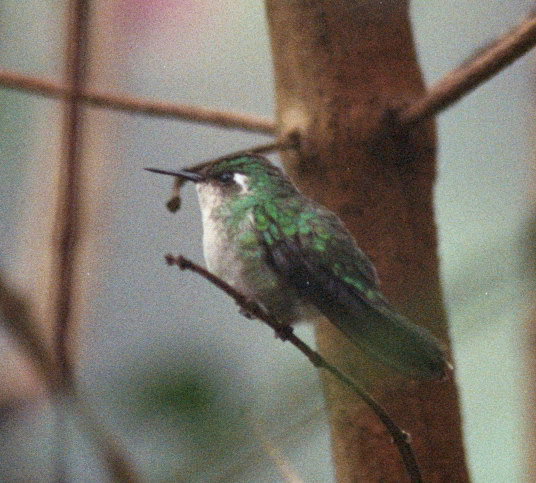- Abeillia abeillei
Identification
This is a tiny hummingbird with a short, straight, dark bill.
Both sexes are green above and have a white post-ocular spot.
The male has mostly grey underparts, with green on the flanks. It has an emerald green throat and black bib, both of which are usually only visible in good light.
The female has white underparts with some green on the flanks. The post-ocular spot extends downwards to form a pale line behind the eye.
Note that the plate in Howell and webb (1995) gives a slightly misleading impression of the shape of this species; showing a short-tailed dumpy bird, when this is not generally the appearance in the field.
Distribution
This species has a very small world distribution limited to the highlands of the southern portion of Mexico (mainly Oaxaca and Chiapas) through southern Guatemala, much of Honduras, western Nicaragua and scattered locations in El Salvador. Throughout this range it is generally very locally distributed and rarely reported, though the lack of records may be in part due to its preference for thick dark forest.
Taxonomy
The Emerald-chinned Hummingbird is the only member of the genus Abeillia.
Subspecies
There are two subspecies[1]:
- A. a. abeillei:
- A. a. aurea:
- Mountains of southern Honduras and northern Nicaragua
Habitat
Tends to be found in lower elevation cloud forest and evergreen forest, though can also be found in pine-evergreen forest. Sometimes occurs in edge habitat, but more frequently enountered inside the forest. Howell and Webb (1995) gives the altitude range as 1000-2200m.
Behaviour
The behaviour of this species is almost completely unknown. Howell and Webb (1995) gives the nesting season as February and March. Birds seen leking in southern Guatemala between October and January, at least. Small groups of males sit in leks 10 to 15m from each other on fairly low twigs in dense vegetation making high pitched whispered whistles.
References
- Clements, J. F., T. S. Schulenberg, M. J. Iliff, B.L. Sullivan, C. L. Wood, and D. Roberson. 2012. The eBird/Clements Checklist of Birds of the World. 6th ed., with updates to October 2012. Ithaca: Cornell Univ. Press. ISBN 978-0801445019. Spreadsheet available at http://www.birds.cornell.edu/clementschecklist/downloadable-clements-checklist
Recommended Citation
- BirdForum Opus contributors. (2025) Emerald-chinned Hummingbird. In: BirdForum, the forum for wild birds and birding. Retrieved 18 May 2025 from https://www.birdforum.net/opus/Emerald-chinned_Hummingbird
External Links
A page on this species with a number of photos can be found on http://tomjenner.com/mayanbirding/thebirds_emerald_chin_humm.html




